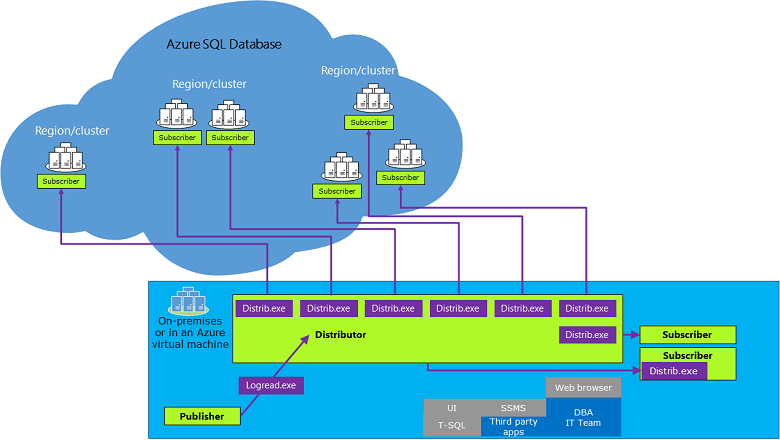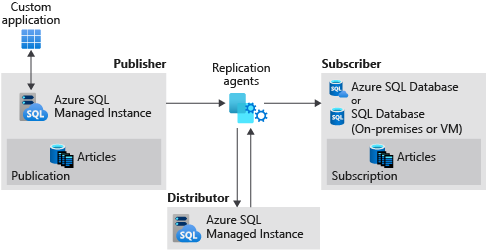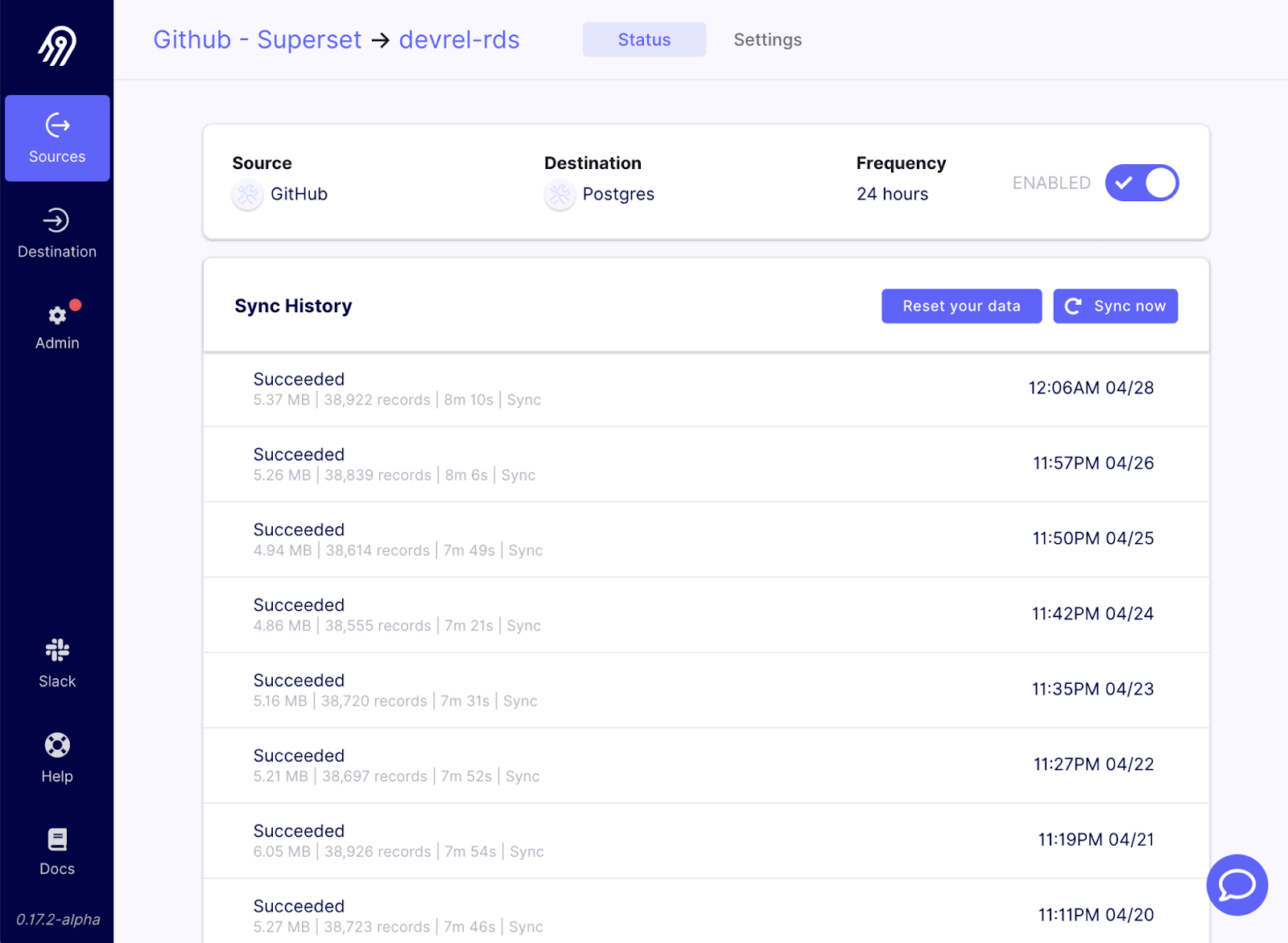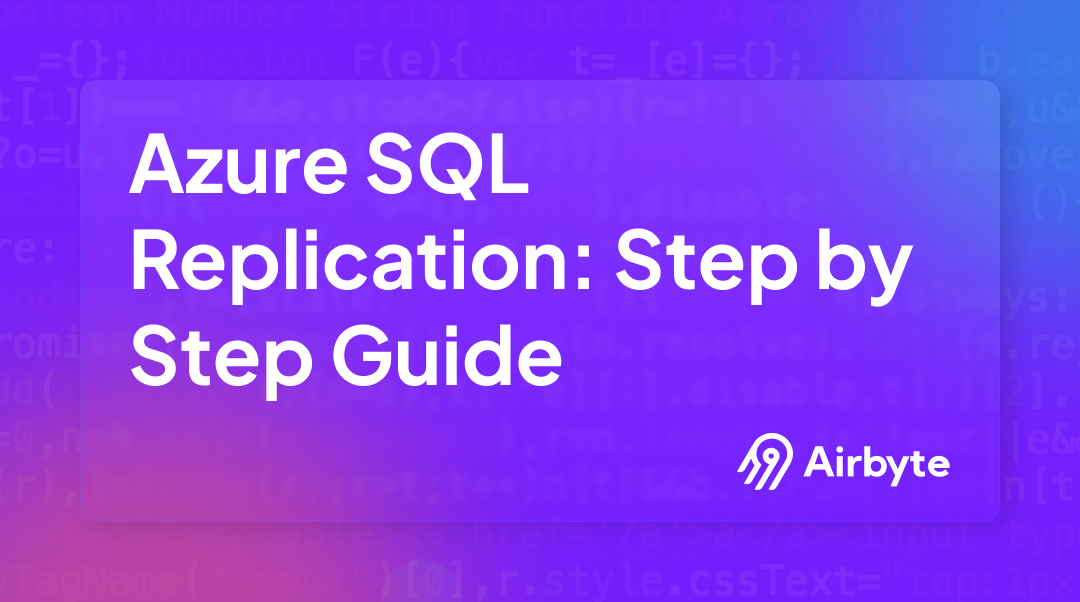Azure SQL Replication: Step-by-Step Guide
Summarize this article with:
✨ AI Generated Summary
Azure SQL replication enhances data availability, reliability, and performance by copying and synchronizing data across multiple databases using various replication types such as transactional, snapshot, merge, peer-to-peer, and bidirectional. Key components include publishers, subscribers, distributors, publications, and agents that manage data flow and consistency. Additionally, tools like Airbyte offer no-code, flexible, and incremental data replication solutions to simplify and optimize data integration workflows.
Replication is a crucial aspect of database management. It helps enhance data availability, reliability, and performance across systems. Azure SQL, Microsoft's cloud-based relational database service, is one such database platform that offers robust replication capabilities to meet a wide range of operational requirements.
Azure SQL supports various deployment options, including single databases, elastic pools, and managed instances, allowing you to customize replication strategies to match your needs.
In this blog, you will learn about the intricacies of Azure SQL Replication, explore its types, benefits, and detailed step-by-step implementation process.
What is Azure SQL Replication?

Azure SQL replication is a set of technologies provided by Microsoft Azure. It is designed to facilitate the copying and distribution of data and database objects from a source Azure SQL database to one or more destinations.
This capability allows you to maintain consistent and synchronized copies of your organizational data across different environments, whether hosted in the Azure cloud or on local premises.
The benefits of using Azure SQL replication include improved data availability, disaster recovery preparedness, and enhanced scalability for read-intensive workloads. It also offers dedicated resources for reporting and analytics and support for offline data processing without impacting production systems.
Azure database replication can be of different types—snapshot, transactional, and merge replication, each designed to address specific data synchronization requirements.
The Key Components of a SQL Server Replication
SQL Server replication involves several components that collaborate to ensure data is accurately copied and maintained across multiple databases. Here are the key components involved in SQL Server replication:
Articles
Articles are the fundamental building blocks of SQL Server replication, representing the individual database objects such as tables, views, stored procedures, etc., selected for replication. Administrators can fine-tune replication by applying filters to include or exclude rows and columns selectively.
Publication
A publication serves as a container within the publisher, grouping together a set of articles, such as tables, views, and stored procedures, designated for replication. It offers a convenient way to manage and configure properties, including filtering criteria and data transformations, that apply to all included articles.
Publisher
The publisher is the original database that includes the data and objects you want to replicate. Within the publisher, you can define multiple publications, each acting as a blueprint specifying which database objects, such as tables, views, or stored procedures, to replicate.
Distributor
The distributor is an intermediary that holds the replication data, article definitions, and metadata. It coordinates the efficient delivery of replication data from the publisher to the subscribers.
Subscriber
The subscriber is the endpoint that receives replicated data and objects from the publisher. It serves as a repository for these objects, ensuring replicated data is integrated and stored.
Subscription
A subscription defines the relationship between the publisher, publication, and subscriber. It specifies how and when the replication occurs, providing a structured framework for a seamless and well-managed data replication process.
Agents
SQL Server agents are background services that automate various database management tasks such as scheduling and executing replication, backups, and other maintenance routines. These agents help maintain the system's operation and ensure data integrity.
Types of Azure SQL Replication
Azure SQL replication provides various methods to cater to specific use cases and synchronization needs. Choosing the right replication type depends on factors like data volume, the need for consistency, and the frequency of updates.
Let's explore the different replication types offered by Azure SQL.
1. Standard Transactional Replication
Transactional replication begins by creating a snapshot of the publication database, capturing both schema and data. After this initial snapshot, subsequent changes made at the publisher are continuously and rapidly sent to the subscriber, maintaining near real-time synchronization.
The process preserves the order and transactional context of these changes, ensuring data consistency across replicas. This type of replication is well-suited for server-to-server environments that require data to be replicated between database servers with minimal delay.
2. Snapshot Replication
Snapshot replication involves capturing a complete copy of the database at a specific point in time. This includes both the schema and data but does not track subsequent changes. Snapshot replication is particularly efficient for smaller databases or situations where large batches of data changes occur quickly; it transmits the entire snapshot at once instead of individual updates.
This replication type is suitable for scenarios where data updates are infrequent or slightly outdated copies are acceptable.
3. Merge Replication
Merge replication starts with a snapshot of the database and tracking changes using triggers on the publisher and subscribers. It supports bi-directional data synchronization, allowing changes made on any replica to be merged periodically.
This method is suitable when multiple subscribers update the same data, subscribers work offline and need to sync later, or when conflict resolution is required.
4. Peer-to-Peer Replication
Peer-to-peer replication offers a robust solution for high availability and scaling out read operations by distributing data across multiple nodes. It utilizes transactional replication to ensure near-real-time consistency of data across the nodes.
An advantage of this approach is that individual nodes can be taken offline for maintenance or upgrades without disrupting the overall system, enhancing reliability and maintainability.
5. Bidirectional Replication
Bidirectional transactional replication allows two servers to function as both publishers and subscribers, exchanging data changes in near real-time.
A critical component of this system is the loopback detection mechanism, which prevents changes from being cyclically replicated between the servers. This setup helps keep both databases synchronized.
In SQL Server 2005 and later, this topology can be set up using either bidirectional or peer-to-peer replication. While both approaches achieve similar results, bidirectional replication may offer performance benefits over peer-to-peer in certain scenarios.
6. Updatable Subscription
Transactional replication also supports updates at subscriber sites through updatable subscriptions, available in two types—immediate and queued.
While immediate updating requires a constant connection to the publisher for real-time propagation of changes, queued updating allows offline changes to be synchronized later.
Subscriber updates are first sent to the publisher and then to other subscribers. For immediate updating, changes are propagated using a two-phase commit process to ensure consistency. On the other hand, queued updating stores changes to be applied later, potentially leading to conflicts that must be resolved based on predefined policies.
Step-by-Step Guide to Implementing Azure SQL Replication
Let’s explore this step-by-step guide to implementing Azure SQL replication, focusing on transactional replication (the most common type):
Requirements:
- Azure Account: An active Azure subscription is required.
- SQL Server Management Studio (SSMS): Install the latest version of SSMS on a machine with network access to both the publisher and subscriber databases.
- Publisher Database: An existing Azure SQL database or Azure SQL Managed Instance you want to replicate.
- Subscriber Database: A target Azure SQL database, Azure SQL Managed Instance, or SQL Server on a VM to receive the replicated data.

Step 1: Prepare the Publisher
The initial step involves preparing your publisher database for replication.
- Use SSMS or T-SQL commands to enable the replication feature on the database.
- Create a publication by defining the data and objects, such as tables and stored procedures, you want to replicate.
- If not already configured, establish a distribution database on your publisher server to manage the data flow to subscribers.
Step 2: Prepare the Subscriber
- Set up a subscription to establish a link between the publisher and the subscriber. This will link the subscriber to the publication you want to replicate.
To do this, use the New Subscription Wizard in SSMS or T-SQL commands.
Step 3: Initialize Replication
With the publisher and subscriber prepared, the next step is initiating the replication process.
- Generate a snapshot of the publication's data and schema. This snapshot, including all the data and database objects that need to be replicated, will serve as the subscriber's baseline.
- Deploy the distribution agent, which is a background process responsible for transferring the snapshot from the publisher to the subscriber database. This will effectively duplicate the publication data and schema on the subscriber.
Step 4: Start Replication
This process involves activating two key agents: the log reader agent and the distribution agent.
- The log reader agent monitors the transaction log of the publisher database for changes like inserts, updates, or deletes. It then sends these changes to the distribution database.
- The distribution agent transfers these changes from the distribution database to the subscriber database, ensuring that the subscriber remains synchronized with the publisher.
Step 5: Monitor and Maintain
The final step, but an ongoing one, is to monitor and maintain your replication setup.
- Regularly check the replication status using tools like SSMS or Azure Monitor.
- Check for errors, latency issues, or other anomalies that might indicate a problem. By promptly addressing any issues, you can minimize disruption.
- Perform regular maintenance, such as updating the replication topology when necessary and applying schema changes cautiously to avoid conflicts.
An Alternative Approach: SQL Server Replication Using Airbyte’s No-Code Data Pipeline
Airbyte is an efficient data integration platform that provides an intuitive interface and pre-built connectors to simplify the process of building data pipelines. These features make it an attractive option for organizations seeking a user-friendly and streamlined way to replicate their SQL Server data.

How to Build A Data Pipeline in Airbyte?
To build a data pipeline in Airbyte, you need to follow three straightforward steps:
Step 1: Connect to the Source
Log in to Airbyte and navigate to the Sources section. Choose the appropriate source from the list of 350+ connectors available. Next, fill in the required configuration details for the selected source, such as authentication credentials, API keys, etc. After entering the details, click Set up source.
Step 2: Connect to the Destination
Navigate to the Destinations section and choose your desired destination connector, such as a data warehouse or data lake. Provide the required information for the destination, and click Set up destination.
Step 3: Create a Connection
Go to the Connections section and choose the source and destination you configured in the previous steps. Now, establish the connection and set up the Replication frequency. You can customize the frequency according to your specific requirements. Once the connection is created, you can monitor its status and performance and make any necessary adjustments to optimize the data pipeline.
Why Choose Airbyte for Data Replication Tasks?
- Flexible Integration Options: Airbyte’s no-code user-intuitive interface allows you to explore the data independently. It also features other developer-friendly options such as PyAirbyte, API, and Terraform Provider to easily integrate with your preferred infrastructure management approach.
- Broad Connector Support: Airbyte offers 350+ connectors for a wide range of data sources and destinations, including SQL Server or Azure Blob Storage. This makes it easy to replicate your data to the desired destination.
- Incremental Replication: Airbyte can help replicate only the changes made since the last synchronization, reducing bandwidth usage and improving overall performance.
- Monitoring and Logging: Airbyte provides robust monitoring and logging capabilities, enabling you to track the status of your replication jobs and troubleshoot any issues that may arise.
- No-code Connector Builder: Airbyte offers three methods for custom connector development: a no-code builder that takes less than 10 minutes, a low-code Connector Development Kit (CDK) that requires 30 minutes, and language-specific CDKs that take approximately 3 hours.
Conclusion
Implementing Azure SQL replication provides an effective solution for enhancing data availability, consistency, and disaster recovery efforts. From real-time data synchronization to complex transactional support, Azure SQL replication is an essential component in cloud database management.
Understanding the different types of replication and the technical components involved can help you tailor your replication strategy to your organizational needs. However, for a more streamlined and efficient data integration process, consider leveraging solutions like Airbyte.
Airbyte is a robust and reliable data integration platform that supports a variety of data sources and destinations. It can assist in optimizing and automating your data integration operations, resulting in smooth data synchronization across your systems.
FAQs
How many times the Azure data is replicated?
Typically, Azure data is replicated three times within the primary region and optionally in a secondary region for disaster recovery. However, the frequency of Azure data replication depends on the specific service and configuration.
Does Azure automatically back up data?
Azure doesn't automatically back up all data by default; it offers the Azure Backup service to help schedule and manage backups for various Azure resources like VMs, SQL databases, and Azure file shares.
How to back up SQL in Azure?
Backing up SQL databases in Azure can be done in two ways:
- Azure SQL Database offers built-in automated backups that you can configure.
- For SQL Server on Azure VMs, you can leverage Azure Backup service to create scheduled backups and store them in a Recovery Services vault.
💡Suggested Read: Aggregation with SQL

